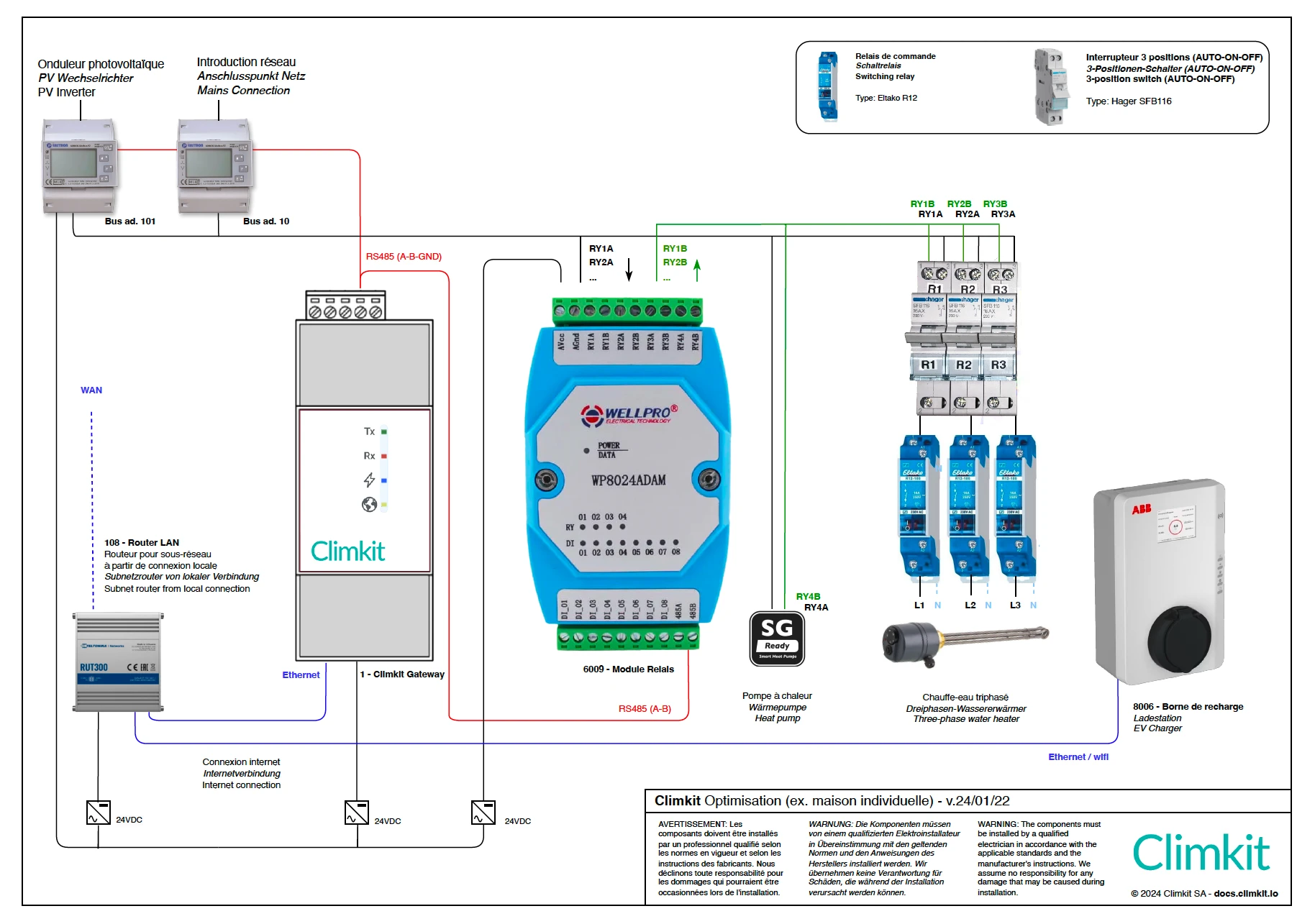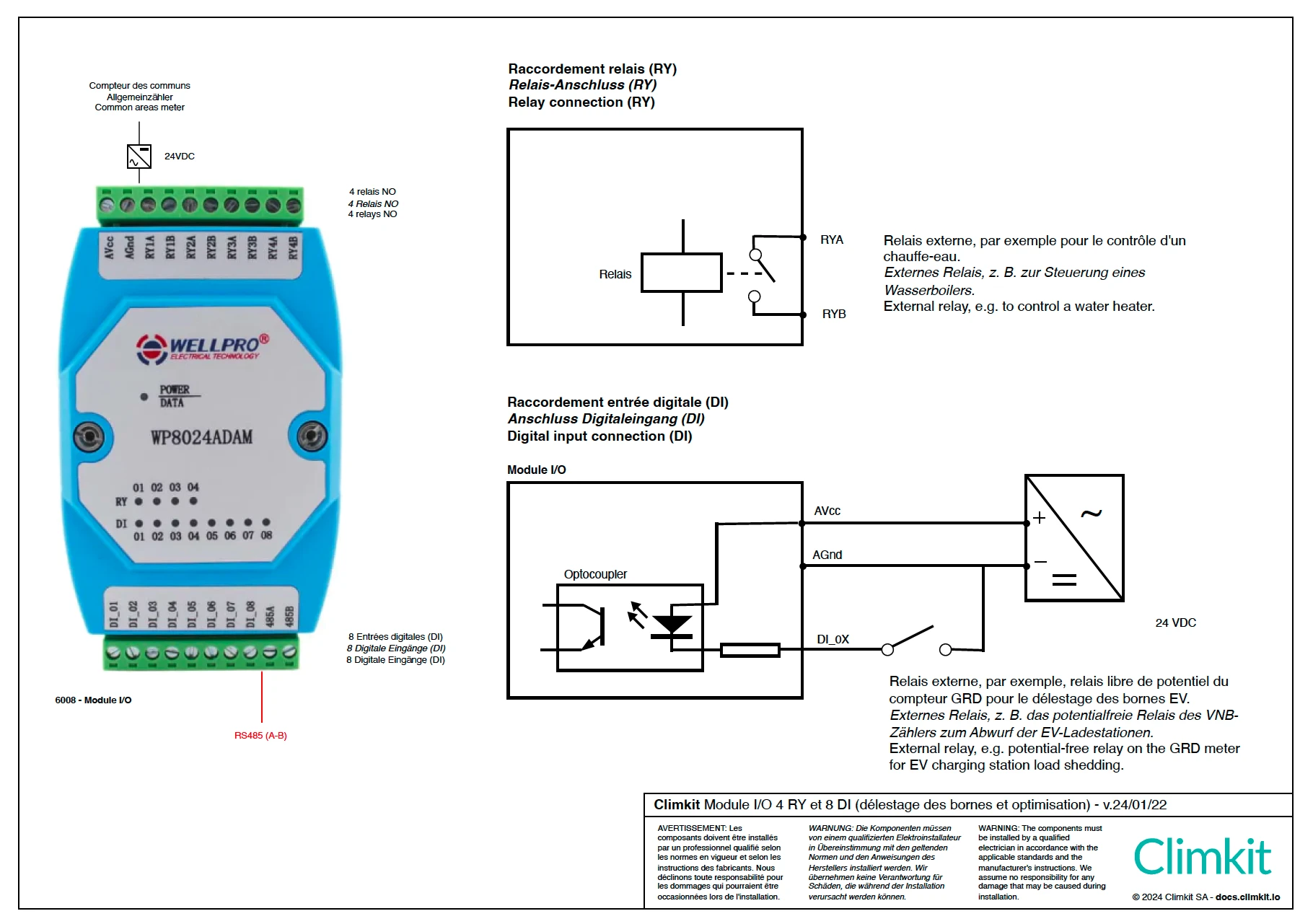Virtual assistant
Installer
Getting Started Guide
Solutions and documentation structure
Equipment ordering and commissioning
General terms and conditions of sale and warranty
Wiring diagrams
Gateway and communication
Community - Electricity Metering - RCP
Heating - Heating metering and water
Mobility - EV Charging Stations
EBike - Recharge electric bikes
Washaccess - Collective laundry manager
Self-consumption optimization
Building energy monitoring
Equipment and installation
Charging infrastructure and relays
Metering infrastructure
Communication infrastructure
Climkit Gateway
4G Router
LAN Router
RS485-Ethernet Converter
Switch ethernet DIN POE
WiFi Network
MBus-RS485 Converter
Storage system (battery)
Configuration and commissioning
Commissioning
Getting Started Guide
Add a router to a site
Add a Climkit Gateway to a site
Electricity meter configuration
Charging station configuration
Configuration of heating and water meters (MBus)
Installation of Shelly relay meters
Optimization via EV relays and charging stations
Checking meter connection status
Advanced configuration
Configuration Gateway
RFID reader and relay meter configuration
IP network configuration and routers
RS485-Ethernet TCP/IP Converters
Configure Teltonika RUT241
Display configuration
Modbus Meter Configuration
Metering data processing
Manually read meter
Inepro PRO380 Meters and various
ABB Terra AC Charging Station Configuration
Wallbox configuration
Firewall rules for Climkit Gateway
Schneider EVlink Pro AC Charging Station Configuration
Zaptec Charging Station Configuration
Owner
Administrative setup
Getting started guide - administrative setup
Form - 1. Contact details
Form - 2. Solutions
Form - 3. Rates
Contract and documents to complete
Owner account
Consumer information flyers
Online access, RFID badge and charging stations
FAQ and other information
Resident
Platform
Platform access
Terminology
Site
Parameters
Creation/edit of a note or to-do item
Closing an open issue
Site statuses
Add/Modify building(s)
The steps for setting up a site
Delete/deactivate a site
Add/Edit Equipment(s)
Modify site basic information
Equipment
Add/modify a gateway
Add/modify a router
Add/modify an electricity meter
Bulk meter insertion
Mass assigning meters to a gateway
Add/edit a distribution zone
Add/modify a charging station
Add/modify a thermal or water meter
Add/edit a DSO meter (FTP transfer)
Remote connection to a Climkit gateway
Administration
Stakeholders
Financial conditions
Visualizing Site Management Conditions
Activating/Deactivating a Solution
Configuration of the Operating Method
Visualizing Financial Conditions
Creation/editing/addition of a financial condition
Removal of a financial condition
Accounts
Create a consumer account
Create a contact
View and download account invoices
Send platform access to a contact
Add/modify billing address
Link an existing account to a site
Changing the correspondence method
Rates and billing points
Creating/editing a billing point
Register a move (relocation)
Account assignment to a billing point
Add/edit default charge advance payment for a billing point
View site consumption rates
Consumption Rate Edition
Creation/editing of a consumption tariff
Creation/editing of a Tariff component
View fixed rates and subscriptions
Customize invoice position labels/titles
View Financial conditions billed at billing points
RFID badges
Accounting
Tools
Meter control
Visualization
Expense accounts
Introduction to the Expense Statement Tool
Create/edit an expense accounting period
Modify expense statement settings
Add/edit a overhead expense invoice on an expense statement
Edit collected advance payments of an expense statement
Specifics of heating and hot water production costs
Check and download meter readings for the cost accounting period
Allocate expenses and generate expense statements
Exporting individual consumptions for the billing period
API
Table of Contents
- Categories
- Installer
- Wiring diagrams
- Self-consumption optimization
Self-consumption optimization
1. Self-consumption Optimization
The Climkit optimization system allows for increasing the self-consumption rate of a photovoltaic installation by controlling certain devices based on solar energy production.
The surplus fed back to the electricity grid is thus limited, and autonomy is also gained by producing, for example, hot water using solar energy.
Devices (water heaters, heat pumps, radiators, pool pumps, etc.) are controlled via a relay.
It is also possible to control certain electric vehicle charging stations (via Wifi or Ethernet).

Detailed connection of a relay to the I/O module
The relay I/O module has 4 relays.

2. Algorithm Operation
The system evaluates the electrical power fed back to or drawn from the grid every minute.
In case of surplus fed back, it activates the various configured and connected devices.
For example, if there is a surplus greater than or equal to 1000 W, it activates the 1000 W water heater.
Conversely, if there is no longer a surplus and energy is being drawn from the grid, the system deactivates the necessary devices to limit the draw.
Devices are activated and deactivated according to the selected operating modes, for example in "Solar only" or "Solar and timer" mode. See Configuration below.
It is not possible to set activation or deactivation priorities among the devices; they are only controlled based on their nominal power to maximize self-consumption.
To be as flexible as possible, it is recommended to connect devices with the lowest possible power so that they activate with even a small surplus.
For example, each phase of a 3000 W water heater can be connected to an independent relay to benefit from three 1000 W steps.
Specific Notes
Minimum power and number of phases of a station
Generally, an electric vehicle requires a minimum of 6A to start charging. Some vehicles require 8A or 10A. A lower minimum can cause an error on the vehicle.
This minimum of 6A is the same for single-phase and three-phase connections: i.e., 1380 W for single-phase 230V or 4140 W for three-phase.
Consequence for optimization: A vehicle connected to a three-phase station requires a minimum solar surplus of 4140 W for the system to start charging.
For small photovoltaic installations (5-8 kWp), the surplus required to activate the station will only be available during summer and mid-day.
In these cases, it is recommended to connect the 3 phases of the station to 3 independent relays or at least to 3 independent switches so that the user can easily switch from one to three phases. See the diagram above.
When changing the number of phases for the station, the main circuit breaker of the station must be turned off, the connection phases engaged or disengaged, and the station turned back on.
The optimization system does not allow for controlling phases and automatically switching from a single-phase to a bi- or three-phase load.
Vehicle Standby
When a vehicle is plugged into the station but the solar surplus is insufficient to initiate charging, the vehicle goes into standby mode until the station supplies it with electricity.
In some cases, the vehicle may go into full standby after some time, and when the station provides it with electricity again, charging will not start until the vehicle is "woken up" by the user.
This case is common when the vehicle is plugged in the evening and the solar surplus will only be available the following morning.
Some vehicles can be updated to prevent these unexpected standbys. Consult the vehicle manufacturer.
Older Vehicles
Some older vehicles (pre-2012-2014) do not support varying power during charging and are therefore not controllable via the optimization system.
Heat Pumps (SG-Ready)
Most modern heat pumps (HP) are equipped with a potential-free contact which, when closed, sends an instruction to the HP's internal management system.
Generally, it is possible to configure the HP to increase its heating setpoint or produce more hot water when this contact is closed.
By connecting a relay from the optimization system to this contact, it is possible to force the HP to activate when the photovoltaic installation produces surplus energy.
Consult the HP manufacturer.
Connecting a Three-Phase Water Heater
Many water heater elements are connected with 3 wires without a neutral. Therefore, a neutral connection is necessary to control each phase individually.
Otherwise, a minimum of two phases is always required for it to engage.
Two relays can then be used to control: phase 1 and 2 with the first relay, and 1 and 3 with the second.
